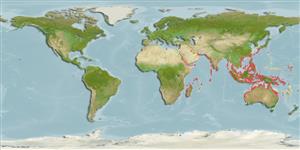>
Eupercaria/misc (Various families in series Eupercaria) >
Labridae (Wrasses) > Corinae
Etymology: Stethojulis: Greek, stetho, stethion = brest; literal = to prick a little breast + Greek, ioulis, a fish dealing with genera Coris or Thalassoma (Ref. 45335).
More on author: Bleeker.
Environment: milieu / climate zone / depth range / distribution range
Écologie
marin récifal; profondeur ? - 18 m (Ref. 90102). Tropical; 35°N - 33°S, 32°E - 168°E
Indo-West Pacific: Persian Gulf (Ref.80050); Red Sea and East Africa to Papua New Guinea, south to Lord Howe Island. Unknown from Micronesia.
Taille / Poids / Âge
Maturity: Lm ? range ? - ? cm
Max length : 15.6 cm TL mâle / non sexé; (Ref. 26587)
Épines dorsales (Total): 9; Rayons mous dorsaux (Total): 11; Épines anales 3; Rayons mous anaux: 11. True form has interrupted mid-lateral stripe. Female with yellow stripe from the tip of snout to just past axil, running below eye where pale silvery-blue; male with continuous mid-lateral line and dark 'ear' (Ref. 48636).
Coastal to outer reef crests. In Japan, it is found in areas of mixed sand, rock and coral (Ref. 9710). Occurs in small groups to about 20 m depth (Ref. 48636). Feeds by sorting small animals from mouthfuls of sand and detritus.
Life cycle and mating behavior
Maturité | Reproduction | Frai | Œufs | Fécondité | Larves
Oviparous, distinct pairing during breeding (Ref. 205).
Randall, J.E., 2000. Revision of the Indo-Pacific labrid fishes of the genus Stethojulis, with descriptions of two new species. Indo-Pac. Fish. (31):42 p. (Ref. 36378)
Statut dans la liste rouge de l'IUCN (Ref. 130435)
Menace pour l'homme
Harmless
Utilisations par l'homme
Pêcheries: sans intérêt; Aquarium: Commercial
Plus d'informations
RéférencesAquacultureProfil d'aquacultureSouchesGénétiqueElectrophoresesHéritabilitéPathologiesTraitementNutrientsMass conversion
Outils
Articles particuliers
Télécharger en XML
Sources Internet
Estimates based on models
Preferred temperature (Ref.
123201): 24.3 - 29.2, mean 28.4 °C (based on 2808 cells).
Phylogenetic diversity index (Ref.
82804): PD
50 = 0.5010 [Uniqueness, from 0.5 = low to 2.0 = high].
Bayesian length-weight: a=0.00977 (0.00548 - 0.01741), b=3.07 (2.92 - 3.22), in cm total length, based on LWR estimates for this species & Genus-body shape (Ref.
93245).
Niveau trophique (Ref.
69278): 3.4 ±0.3 se; based on diet studies.
Résilience (Ref.
120179): Haut, temps minimum de doublement de population inférieur à 15 mois (Preliminary K or Fecundity.).
Fishing Vulnerability (Ref.
59153): Low vulnerability (10 of 100).
Nutrients (Ref.
124155): Calcium = 101 [60, 174] mg/100g; Iron = 0.771 [0.443, 1.442] mg/100g; Protein = 18.5 [15.6, 20.7] %; Omega3 = 0.152 [0.096, 0.245] g/100g; Selenium = 20.8 [12.1, 38.4] μg/100g; VitaminA = 150 [46, 547] μg/100g; Zinc = 1.85 [1.26, 2.92] mg/100g (wet weight);
